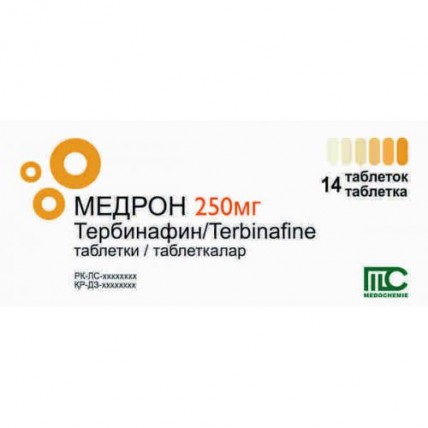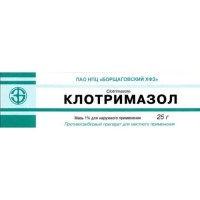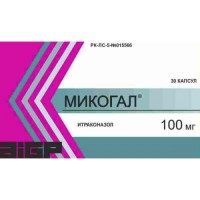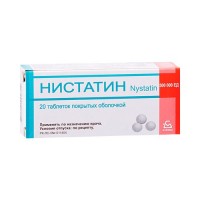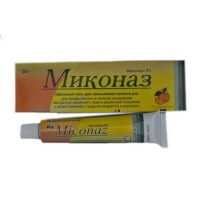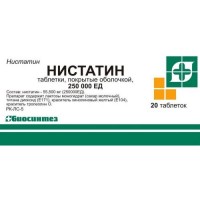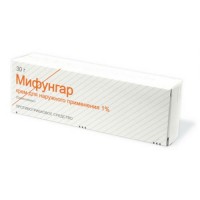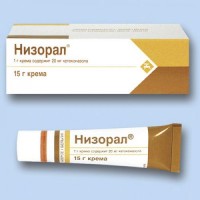Medron 250 mg (14 tablets)
- $37.70
The instruction for medical use of medicine Medronum Trade nazvaniyemedron the International unlicensed name Terbinafin Lekarstvennaya a form of the Tablet of 250 mg Structure One tablet contains active agent - a terbinafin a hydrochloride of 281.25 mg (it is equivalent to a terbinafin of 250.00 mg) excipients: a hydroksipropilmetiltsellyuloza, sodium of starch glikolit, cellulose microcrystalline, silicon dioxide colloidal, magnesium stearate. The description of the Tablet of round shape, white color, with a flat surface, with risky on one party, with a diameter of 10.5 mm. Pharmacotherapeutic group Drugs for treatment of diseases of skin. Antifungal drugs for treatment of diseases of skin. Antifungal drugs for system use. Terbinafin. The code of automatic telephone exchange D01BA02 the Pharmacological Pharmacokinetics Terbinafin properties is well soaked up (& by gt, 70%) after oral introduction. As a result of the first passing through a liver the absolute bioavailability of a terbinafin is about 50%. After single dose of a terbinafin in a dose of 250 mg (orally), average peak plasma concentration is reached in 1.5 h and makes 1.30 mkg/ml. Plasma concentration decreases trekhfazno, with the elimination half-life (Т½) in a final phase making 16.5 days. For 28 day when steady state is reached approximately for 70%, the peak concentration of a terbinafin increases, on average, by 25%, and AUC plasmas increases by 2.3 times, in comparison with use of a single dose. From increase in AUC plasma the effective elimination half-life of a terbinafin making about 30 hours is calculated. Meal does not influence considerable bioavailability of a terbinafin (increase in AUC less than 20%). Linking with proteins of blood plasma makes about 99%. Terbinafin collects in a lipophilic corneal layer, also gets into secretion of sebaceous glands that creates high concentrations in hair follicles, hair and in the skin rich with sebaceous glands. There are data confirming what terbinafin gets into nail plates into the first several weeks after the beginning of therapy. Terbinafin is quickly metabolized, with the participation of not less than seven CYP enzymes, at the same time the main role is played by CYP2C9, CYP1A2, CYP3A4, CYP2C8 and CYP2C19 enzymes. The metabolites which are formed at the same time have no antifungal activity and are removed mainly with urine. Clinically significant changes in pharmacokinetics depending on age are noted, however at patients with a renal failure or a liver drug clearance rate can be slowed down that leads to increase in concentration of a terbinafin in blood (at use of a single dose of a terbinafin for patients with damage of kidneys (clearance of creatinine & lt, 50 ml/min.) or with earlier existing liver diseases, the clearance of a terbinafin decreases approximately by 50%). A pharmacodynamics Medronum – the allylamine possessing a wide range of antifungal activity. At low concentration terbinafin works fungicidally for dermatophytes, mold and some dimorphous mushrooms. The activity concerning barmy fungi is fungicidal or fungistatic, depending on a species of mushrooms. Terbinafin suppresses biosynthesis of sterols in a mushroom cell at an early stage, leading to a lack of an ergosteril and intracellular cumulation of squalene that causes death of cells of a mushroom. Terbinafin inhibits a skvalenepoksidaza in a mushroom cell membrane which is not connected with a system P450 cytochrome. At oral administration, drug is defined in skin in the concentration providing fungicide action. Indications the Fungal infections of skin and nails caused by Trichophyton dermatophytes (T. rubrum, T. mentagrophytes, T. verrucosum, T. violaceum), Microsporum canis and Epidermophyton floccosum: - a trunk dermatofitiya - a pakhovy dermatomycosis - a foot dermatofitiya - an onychomycosis the Route of administration and doses of the Tablet for intake. Medronum is recommended to appoint on 250 mg once a day. Duration of a course of treatment depends on indications and weight of an infection. Dermatofitiya of foot (interdigital, bottom types): from 2 to 6 weeks. Dermatofitiya of a trunk: 4 weeks. Pakhovy dermatomycosis: from 2 to 4 weeks. Onychomycosis (fungal infection of a nail plate): duration of a course of treatment is 3-6 months. In rare instances, especially, at damage of a nail of thumbs, treatment can be required more than 6 months. Therapy duration at patients of young age, and also patients with fast growth of a nail plate, can be less than 3 months. In other cases of, usually, rather 3-month therapy. Full regression of signs and symptoms of an infection is possible in several weeks after the end of treatment. Patients with reduced function of kidneys the Use of Medronum is not recommended, because of insufficiency of data on safe use of a terbinafin for this group. Patients of advanced age (65 years are also more senior) Change of the mode of dosing is not required. However, it is necessary to consider a possibility of an abnormal liver function or kidneys, at this group of patients, Side effects Side effects appear, as a rule, from easy to moderate degree and have temporality. Very often (& gt, 1/10) - decrease or loss of appetite, feeling of overflow of a stomach, dyspepsia, nausea, pain in a stomach, a meteorism - rash, urticaria - an arthralgia, myalgia Often (& gt, 1/100 до<, 1/10) - a headache Infrequently (& gt, 1/1.000 до<, 1/100) - the food faddism, decrease in flavoring sensitivity, loss of flavoring sensitivity (usually passing, it is restored in several weeks after the termination of administration of drug), is rare (& gt, 1/10.000 до<, 1/1.000) - an abnormal liver function (including a liver failure), increase in level of liver enzymes, jaundice, a cholestasia, hepatitis - paresthesia, a hypesthesia, dizziness, a general malaise, vertigo, the exhaustion is Very rare (& lt, 1/10.000) - a neutropenia, thrombocytopenia, an agranulocytosis - anaphylactoid reactions (including a Quincke's edema), the skin and system lupus erythematosus - vertigo - Stephens-Johnson's syndrome, a toxic epidermal necrolysis, a multiformny erythema, a toxic erythema, exfoliative dermatitis, bullous dermatitis) - a fotosensebilization (in case of identification on skin of rashes of the progressing character, treatment by Medronum should be stopped) - an alopecia Frequency is unknown (it is impossible to establish frequency on the basis of the available data) - anemia, a pancytopenia - anaphylactic reaction, reactions as a serum disease - a condition of alarm, a depression - disturbance of sense of smell, including constant disturbance of sense of smell, a hyposmia - visual disturbances, decrease in visual acuity - relative deafness, a hearing disorder, sonitus - a vasculitis - psoriazopodobny rash or exacerbation of psoriasis, sharp generalized exanthematous pustulez, the medicinal urticaria (which is followed by an eosinophilia and system symptoms) - a rhabdomyolysis - fatigue, a grippopodobny state, fervescence - increase in level of a kreatinfosfokinaza - loss of weight (owing to long decrease in flavoring sensitivity, leading to decrease in consumption of food and loss of weight) Contraindications - hypersensitivity to active agent or to any excipient of drug - an acute and chronic liver failure - the lactation period - children's and teenage age up to 18 years Medicinal interactions the Clearance of a terbinafin can be accelerated by the medicines inducing metabolism or slow down the drugs inhibiting P450 cytochrome. In a case, impossibility to exclude the accompanying intake of these drugs, dose adjustment of a terbinafin is recommended. Drugs the plasma concentration of a terbinafin strengthening pharmacological action or raising: Cimetidinum reduces clearance of a terbinafin by 30%. Flukonazol increases indicators of Cmax and AUC of a terbinafin by 52% and 69%, respectively, in connection with suppression of activity of CYP2C9 and CYP3A4 enzymes (similar increase in indicators is possible at simultaneous use with terbinafiny drugs ketokonazol and Amiodaronum, overwhelming both CYP2C9 and CYP3A4 enzymes) Drugs snizizhayushchy action or plasma concentration of a terbinafin: Rifampicin increases clearance of a terbinafin by 100%. Influence of a terbinafin on other Terbinafin medicines increases plasma concentration and strengthens effect of the following drugs: Caffeine. Terbinafin reduces clearance of the caffeine entered intravenously by 21%. Medicines CYP2D6, metaboliziruyemy with participation (tricyclic antidepressants, β-adrenoblockers, selective serotonin reuptake inhibitors, dextromethorphan, antiarrhytmic drugs (including class 1A, 1B and 1C) and monoamine oxidase inhibitors like B). Terbinafin suppresses CYP2D6 - the mediated metabolism that is clinically significant at combined use of drugs, metaboliziruyemy this enzyme, especially, when there is a narrow therapeutic range. Desipramine. Terbinafin reduces clearance of desipramine by 82%. Joint reception of which with terbinafiny results drugs in absence or insignificant influence. Terbinafin has the insignificant potential for suppression or strengthening of clearance of the majority of the drugs which are metabolized through other enzymes of P450 cytochrome (tolbutamin, terfenadin, to triazoles, oral contraceptives), except for the drugs which are metabolized with participation of CYP2D6. Terbinafin does not affect clearance of antipyrine or digoxin. Influence of a terbinafin on pharmacokinetics of a flukonazol is noted. Also clinically significant interaction between terbinafiny and the potential accompanying co-trimoxazole use (Trimethoprimum + sulfamethoxazole), a zidovudine or theophylline is noted. The patients accepting terbinafin along with oral contraceptives have messages about cases of disturbance of a menstrual cycle (intermenstrual bleeding and an irregular menstrual cycle) (however, the frequency of these disturbances remains within the frequency of side reactions at the patients accepting only oral contraceptives). Terbinafin weakens action or reduces plasma concentration of medicines: Cyclosporine. Terbinafin increased clearance of cyclosporine by 15%. Warfarin. At combined use of a terbinafin with warfarin, changes of indicators of the international normalized relation and (or) a prothrombin time has come to light. Special instructions Before prescribing of Medronum it is necessary to estimate the anamnesis of earlier available liver diseases, to carry out functional hepatic tests. Hepatotoxicity of drug can be noted as at patients with earlier available liver diseases, and without therefore periodic monitoring of function of a liver is recommended (in 4–6 weeks of treatment). The patients accepting terbinafin have data on very exceptional cases of a serious liver failure, some of them had a lethal outcome or demanded liver transplantation (in most cases serious basic general diseases were the reason of a liver failure, and relationship of cause and effect with reception of a terbinafin was doubtful). Use of the drug Medronum should be stopped in case of signs or symptoms of an abnormal liver function (naggers, lack of appetite, constant nausea, vomiting, pain in right hypochondrium, urine darkening, decolouration a calla, exhaustion, fatigue), increases in levels of indicators of functional hepatic tests, even if the interrelation with administration of drug is not established. It was very seldom reported about manifestation of serious reactions from skin (Stephens-Johnson's syndrome, a toxic epidermal necrolysis) at the patients receiving terbinafin. In case of appearance of an enanthesis the treatment by Medronum should be stopped. It is necessary to be careful when prescribing drug to the patients having psoriasis in the anamnesis as there are messages about very exceptional cases of exacerbation of psoriasis. There are data on emergence of pathological changes from blood (neutropenia, an agranulocytosis, thrombocytopenia, a pancytopenia) for the patients receiving terbinafin. It is necessary to estimate the cause of any pathological change from blood at the patients accepting Medronum and to consider a question of possible change of the mode of treatment, including the treatment termination by this drug. Use of a terbinafin for patients with a renal failure (clearance of creatinine less than 50 ml/min. or level of creatinine in blood plasma more than 300 µmol/l) is not rather studied therefore use of Medronum for these patients is not recommended. It is necessary to be careful when prescribing drug to patients with a lupus erythematosus as there are messages about very exceptional cases of exacerbation of a disease. Pregnancy and the period of a lactation Medronum should not be applied during pregnancy, except for cases when the clinical condition of mother demands treatment by an oral terbinafin, and the advantage expected for mother exceeds any potential risk for a fruit. Terbinafin gets into breast milk therefore to the women nursing treatment by Medronum is not appointed. Features of influence of drug on ability to run the vehicle or potentially dangerous mechanisms Considering possibility of side effects of drug, for example, of dizziness, it is necessary to be careful when driving or the mechanisms requiring special attention. Overdose Symptoms: a headache, dizziness, nausea, pains in epigastric area. Treatment: drug withdrawal, intake of activated carbon, if necessary performing symptomatic therapy. A form of release and packing On 7 tablets in blister strip packaging from a film of polyvinylchloride/polyvinyldichloride and aluminum foil. On 2 planimetric packs together with the instruction for use in the state and Russian languages place in a pack from cardboard. To Store storage conditions in the dry, protected from light place, at a temperature not above 25 °C. To store out of children's reach! A period of storage 3 years not to use drug after expiry date. Prescription status According to the prescription of Proizvoditel Medokemi Ltd, Limassol. CYPRUS 1-10 Constantinoupoleos Street, 3011, Limassol, Cyprus, tel. 357-25-867600, fax. 357-25-560863 Holder of the registration certificate and packer of Medokemi Ltd, Limassol. CYPRUS the Address of the organization accepting in the territory of the Republic of Kazakhstan claims from consumers on quality of the products (goods) and responsible for post-registration observation of safety of medicine Representative office of Medokemi LTD in the Republic Kazakstan 050008 Almaty, Kazybek St. bi 41
to Develop office 1
to Develop office 1
